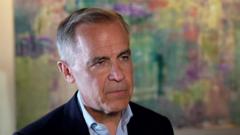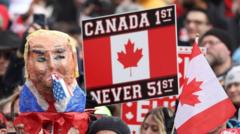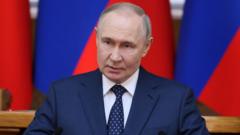As Canadians head to the polls today, they are faced with making a significant decision that could redefine the country’s political landscape. The looming trade war initiated by President Trump has drastically altered the election dynamics, giving a crucial edge to the Liberal Party led by new Prime Minister Mark Carney, who entered the race just last month. Polling trends show a narrowing advantage for Carney's Liberals over Pierre Poilievre's Conservatives, despite the latter once leading by a substantial margin.
Canada’s Critical Election: Trade Wars and Voter Priorities

Canada’s Critical Election: Trade Wars and Voter Priorities
Canadians brace for a crucial election as tensions rise over trade wars and economic instability, with voters grappling with choices between liberal and conservative leaders.
The election is a critical juncture for the nation, which is now reeling from both rising economic uncertainties and President Trump’s aggressive tariffs targeting Canadian exports. The Conservatives, a once seemingly unbeatable party, must contend with the fallout from Trudeau’s resignation and the public’s re-evaluation of leadership following months of economic turbulence.
Across Canada’s expansive geography, voters will determine their parliamentary representatives in ridings—a system where the candidate with the most votes wins. With 343 seats up for grabs, the challenge remains for both main party leaders to solidify their support with differing visions for Canada’s future.
Mark Carney, 60, aims to position himself as a stabilizing force, promising to use his financial expertise to combat the repercussions of the U.S. trade policies, while Pierre Poilievre, 45, pushes for deregulation and a smaller government, despite drawing criticism for his associations with Trump-like rhetoric.
Canada's political battlefield also features the New Democratic Party, Bloc Quebecois, and the Green Party, though they are expected to secure only a fraction of the parliamentary seats. Many voters note the rising cost of living, particularly in housing, as a critical factor influencing their votes.
While voting hours vary across time zones, polls are set to close as the evening progresses, with results expected late tonight. Observers anticipate that the outcome will significantly shape Canada’s approach not only to domestic policies but also to navigating the complexities of its relationship with the United States in the years to come.
As challenges loom large and sentiments run high, the battle for Canada’s future rests in the hands of its voters on this defining election day.
Across Canada’s expansive geography, voters will determine their parliamentary representatives in ridings—a system where the candidate with the most votes wins. With 343 seats up for grabs, the challenge remains for both main party leaders to solidify their support with differing visions for Canada’s future.
Mark Carney, 60, aims to position himself as a stabilizing force, promising to use his financial expertise to combat the repercussions of the U.S. trade policies, while Pierre Poilievre, 45, pushes for deregulation and a smaller government, despite drawing criticism for his associations with Trump-like rhetoric.
Canada's political battlefield also features the New Democratic Party, Bloc Quebecois, and the Green Party, though they are expected to secure only a fraction of the parliamentary seats. Many voters note the rising cost of living, particularly in housing, as a critical factor influencing their votes.
While voting hours vary across time zones, polls are set to close as the evening progresses, with results expected late tonight. Observers anticipate that the outcome will significantly shape Canada’s approach not only to domestic policies but also to navigating the complexities of its relationship with the United States in the years to come.
As challenges loom large and sentiments run high, the battle for Canada’s future rests in the hands of its voters on this defining election day.





















